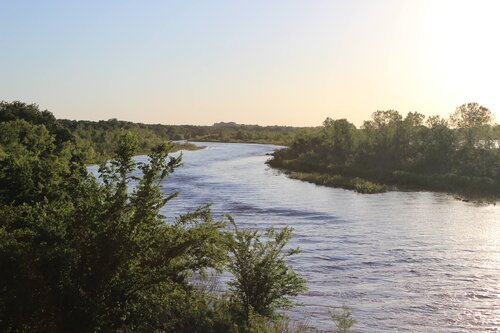 Newcastle became a dot on the map with the opening of a new post office March 26, 1894 and a population of 25. The area had previously been served by the nearby William P. Leeper Post Office, opened in 1888, but closed in 1892 after Leeper was shot in a fencing dispute. The mail office was established on the Minco to Norman road in Section 11, Township 9 North, Range 4 West. Eulalie V. Kelley was the first postmaster. In 1905, postmaster Alonzo Haun moved the facility to his general store in Section 14, Township 9 North, Range 4 West.
Newcastle became a dot on the map with the opening of a new post office March 26, 1894 and a population of 25. The area had previously been served by the nearby William P. Leeper Post Office, opened in 1888, but closed in 1892 after Leeper was shot in a fencing dispute. The mail office was established on the Minco to Norman road in Section 11, Township 9 North, Range 4 West. Eulalie V. Kelley was the first postmaster. In 1905, postmaster Alonzo Haun moved the facility to his general store in Section 14, Township 9 North, Range 4 West.
Newcastle lay in the Chickasaw Nation. The community's first residents included Choctaw, Chickasaw, and individuals who had married into those tribes. Many were involved in ranching. By 1907, the community had a subscription school, a cotton gin, two stores, and two blacksmiths.
Changes spurred Newcastle's growth throughout the 1920s. In 1920 the town's post office was relocated one mile east on land donated for a public school and a church. In 1922, work started on a South Canadian River bridge. The steel thru-truss bridge with timber flooring was Oklahoma's first federal aid project and a part of the Ozark Trail that was to link Oklahoma City to Amarillo, Texas. Although the trail was never fully completed, the bridge stayed. It opened on April 23, 1923, and cost $321,393.38 to build. The bridge attracted businesses and allowed for the construction of Highway 62 through Newcastle in 1927.
 Until the mid-twenties, there was a major river ford at May Avenue that was used whenever the water wasn't too deep. Farmers from Newcastle forged the river with their horses and wagons and traveled up May Avenue on their way to the Oklahoma City Farmer's Market by Western and Reno. Today, only a single section of the old Newcastle Bridge remains alongside the Interstate 44 bridge after having received significant damage during the tornado outbreak of 2013.
Until the mid-twenties, there was a major river ford at May Avenue that was used whenever the water wasn't too deep. Farmers from Newcastle forged the river with their horses and wagons and traveled up May Avenue on their way to the Oklahoma City Farmer's Market by Western and Reno. Today, only a single section of the old Newcastle Bridge remains alongside the Interstate 44 bridge after having received significant damage during the tornado outbreak of 2013.
During World War II, Newcastle's population stood at approximately 100. During the war five local men gave their lives in defense of their country. Another was captured in the Philippines and spent more than three years as a Japanese prisoner. Soon after Japan surrendered, a tornado swept through Newcastle and destroyed the school and much of the business section. The twister touched down the evening of September 25, 1945, moving from the southwest to the northeast.
The limits of Newcastle essentially comprised the post office and school district until around 1960, when Oklahoma City began annexing huge chunks of land across the river. Incorporated January 18, 1962 as South Newcastle, it expanded its area to some 16,000 acres. Nearby Tuttle and Blanchard expanded as well to attempt to prevent Oklahoma City from trying to annex across the Canadian River. A petition to change the name to Newcastle followed in 1965.
Census records indicate a population of 1,271 in 1970, but by the mid-1970s, Oklahoma City had expanded past SW 74th Street, populating near the Interstate 44 corridor, which spurred growth in Newcastle. The population hit 3,076 in 1980 and 5,434 by 2000. In the 1980s, Newcastle annexed territory that lies near Norman, Oklahoma (north of State Highway 9).
Cotton, ranching, and the dairy industry, once important to the local economy, declined with subdivisions and commercial development taking over former agricultural lands. At the end of the twentieth century the public school system was Newcastle's largest employer. The 2010 census recorded 7,685 residents and the population is estimated to be over 10,000 by 2020.